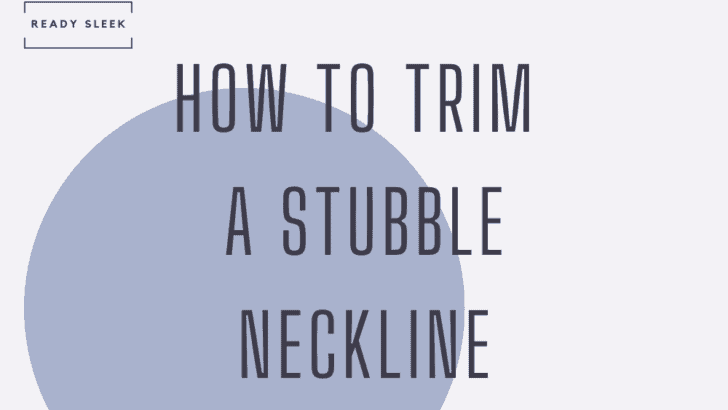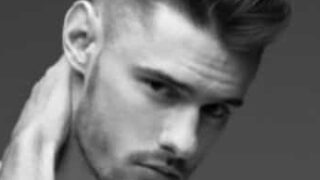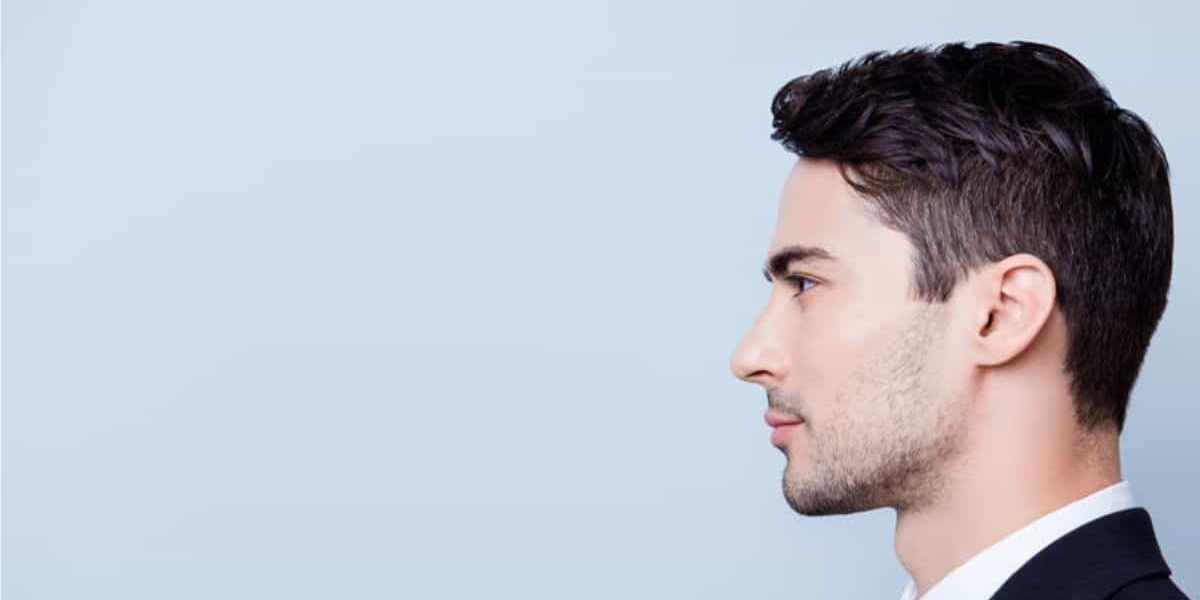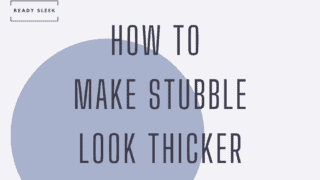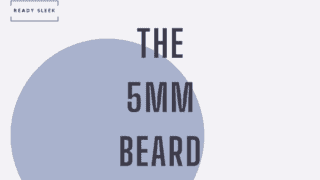Trimming a stubble beard neckline is simple but often botched. In a nutshell, how is it done?
To trim a stubble beard neckline it’s important to first properly plot out where you want it to be. This is the best way of preventing a high neckline. Using a gradual reduction in the size guard length of your trimmer can achieve a “faded” neckline, which some people feel is more natural-looking. A sharper border can be achieved by trimming and then shaving everything underneath the neckline.
As well as going through this technique in more detail, we’ll also briefly discuss what a neckline is, where it should be, and how to fix it if it goes wrong.
By the way, if you’re looking for a list of the best stubble grooming products on the market today (including neckline templates), check this article out too.
“Should I shave my neck when growing a beard?”
This question is asked a lot more often than you might think. Is it really necessary to remove the hair from your neck?
When answering a question like this we often preface it by saying – well, technically no. It isn’t necessary.
But is it advised? Yes. Yes it is. There’s something quite unsettling about seeing a man’s beard crawl down his neck towards his chest hair. Neck hair and chest hair are a pair best kept apart at all times.
The “neckbeard” is a style reserved for those who either don’t care or have literally no clue. Considering you’re reading a style blog, I’m guessing you don’t fall into these categories.
Having this sort of neck rug and not having a clearly defined neckline looks unkempt, uncomfortable, and unprofessional.
Sorry if this sounds a little one-sided. If you haven’t figured it out yet, yes you should. But before we delve deeper into how to strim a stubble beard neckline, let’s first clear up the definition.
What is a neckline?
Your stubble beard neckline is the border between your beard and your neck. It’s where your beard ends and your neck skin begins.
If left to its own accord, it will be scruffy and look poorly defined. This has the potential to destroy efforts made by those chasing the stubble dream.
Knowing how to properly trim and maintain the neckline is one of the pillars of modern beard grooming. This together with knowing how to do the same with the cheek line, of course.
It can give a stubble beard an air of professionalism and finesse. Plus, it can give the jaw a phenomenal definition and contour the face beautifully.
Where should the neckline be?
After having gone on about how great necklines are for most of this article so far, it’s time to answer a question that has eluded novice beardsmiths for generations.
There is no clear anatomical landmark detailing where the neckline should be.
It’s important to understand that one man’s neckline is not necessarily another man’s neckline.
Determining your own optimal stubble beard neckline is an important part of your journey. You’ll come to realize what border suits you best over time.
Having said this, there are certain rules you should bear in mind. They’ll more than likely help you find what you want, sooner.
- The shorter your beard length, the higher you can go. Considering this article is specifically about stubble, your neckline can afford to be a little higher than for those with longer beards.
- Watch out for that jawline. A situation you don’t want is when the neckline is so high that your beard appears to end at or even before your jawline. This would be particularly obvious when you open your mouth. For this reason, stick to the technique we teach you in this tutorial and you won’t go too far wrong. You don’t want your face looking too big for your beard – a very unusual look.
Now that the ground rules are out in the open, let’s dive into how to trim the perfect stubble beard neckline.
How To Trim A Stubble Beard Neckline In 5 Easy Steps
What you’ll need:
- Handheld mirror – Not essential but obviously would come in useful considering the difficulty with viewing your neckline in a mirror directly in front you.
- Electric trimmer – for a stubble style, you’ll need a stubble trimmer. These come with a wider range of incremental size settings for more intricate control. We’re talking in the range of 0.4mm to 5mm. Check out my favorite one on
Amazon by clicking here. - An electric shaver or manual razor. This is if you want a closer shave for a more pronounced contrast between where your beard ends and the neck. In other words, not a fade. Safety razors might be a little trickier to use than the more common cartridge razor but will give you the most control over your neckline. You can, of course, use an electric shaver instead of a manual one – this is purely down to personal preference.
- Moisturizer – the only way to end any trim or shave
Step 1 – Find your perfect neckline
As mentioned earlier on, a high neckline can lead to a double chin look you’ll regret. Before we start though, remember that it’s alright not to get it totally correct on your first attempt.
The great thing about stubble beards is that it doesn’t take long for the hair to grow back to its original length. So even if your neckline is slightly higher than you’d like it, don’t panic. Just wait it out a little.
OK so now it’s time to actually visualize where the neckline should be. Although the exact position may vary slightly based on face shape and whether you’re aiming for a specific style.
But the method I’m about to tell you is hard to go wrong with.
Tilt your head up so you can visualize your neck properly. Imagine a line traveling from the point just beneath one earlobe, down under the jaw and up to the other ear lobe.
This should create a symmetrical “U-shape”. The lowest point of this U-shape (i.e the bottom of this curve) should be around two finger-widths above your Adam’s apple. This is usually around 1.5 inches above your Adam’s apple.
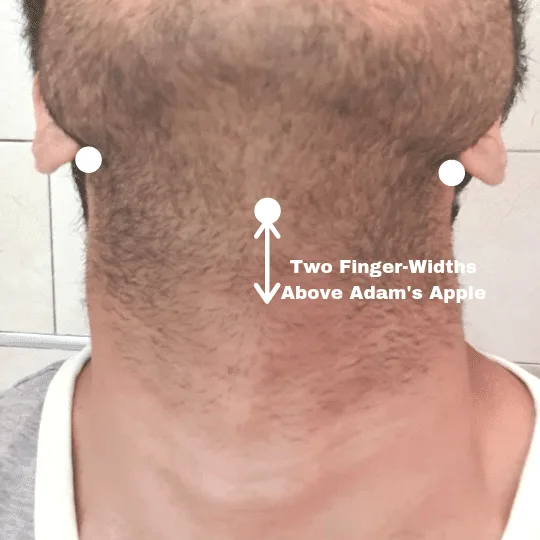
This is your neckline. It’s important to keep the curve looking natural and not too “V-shaped”.
Step 2 – Start Trimming
Trim your entire beard to your usual length first. This will give you a much better idea of what the finished product will look like. Starting with the neckline just wouldn’t make sense.
If you’re looking for a great stubble trimmer, I really like the Philips Norelco Oneblade QP652070 Pro. It gives you very precise control when shaping stubble due to its wide range of length options. The dual-sided blade also makes things incredibly easy.
Check it out on
Once the initial trim is done, shift your attention to the neckline you’ve ingrained into your mind.
This is where a handheld mirror will come in useful, so you can get a good picture of what you’re trimming with the other hand.
At this point, decide whether you want a faded (tapered) neckline. This just means that the border of the neckline isn’t a sharp transition from skin to hair. Some people find this unnatural, some people prefer it, and some people just can’t be bothered to fade it.
Fading will grade the hairs of the neckline, gradually going from the neck skin, to shorter hairs, and then to the longer hairs of the beard.
If you have shorter stubble, there may not be enough length to actually noticeably fade from longer to shorter hairs. But if you have heavier stubble (towards the 5mm mark) it could work with some skillful trimming.
It’s up to you. If you aren’t sure, try fading it first. This way, if you don’t like it, you can always trim and shave over the fade to give a sharper border.
You may decide to try the fade.
If so, simply take your stubble trimmer and set it to a length setting 1mm less than the one you’ve been using.
Using this slightly shorter setting, trim the very edge of the neckline. You’ll notice a very subtle tapering effect. If it isn’t obvious enough, go 1mm shorter and see if that makes a difference.
What this does is it gives a nice and gradual increase in hair length or fade as you transition from skin to neck hair. No sharp borders or cuts. Natural yet sleek.
If this doesn’t appeal to you or just seems like too much effort, your job is much simpler. Using your trimmer’s naked blade (with a stubble trimmer this is usually 0.4 or 0.5 mm) just trim everything beneath the neckline you’ve plotted out for yourself.
After this, you need to neaten and sharpen up the border by going over the area beneath the neckline with a shaver or razor (see Step 4).
No fade. Just a sharply bordered neckline with no fancy stuff.
Easy.
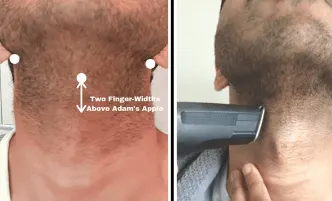
Step 3 – Go in for a closer shave if you want to
This refers to removing all the residual neck stubble beneath the neckline with a razor. A trimmer can only cut so close to the skin. For the sharpest end result, a razor is necessary.
Just whip out your electric shaver or manual razor and shave everything beneath the neckline you outlined in Step 2.
When using a manual razor (cartridge, razor, or straight), ensure the area is properly lubricated with gel or foam first. You can use the foam to outline the border of your neckline, so you know not to shave above it.
As always, avoid re-strokes and do try and shave with the grain first.
Step 4 – Trim any other stray hairs on your neck
If your neck has been neglected for an extended period of time it’s more than likely you’ve got a few extra hairs sprouting out as you go lower down.
There’s nothing attractive about sporadic hairs between your chest and Adam’s apple. Take this opportunity to neaten it all up and give the look a nice, sleek finish.
Step 5 – Moisturize
Wash off any shaving gel, foam, and loose hairs. Then, dab yourself dry with a soft towel.
Following any trimming or shaving session, moisturizing is important.
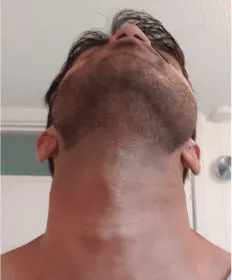
What to do when your neckline is too high
A stubble beard neckline that’s objectively too high is one which is above your jawline. If it is on your jawline itself, it is most likely too high as well. That’s because the neckline travels up the face when the mouth is opened, unfortunately.
The best way to avoid this is to use the method we outlined above.
If when you look at the finished neckline you feel as though you may have gone too high, don’t panic.
As I mentioned earlier, stubble beards are great because they grow back quickly if you were to mess up a specific part of it such as the neckline.
Just wait a week or so for your stubble to grow back around your neck and have another go. Of course, some may take a little longer to grow back their stubble but it shouldn’t be anything too significant.
If you really can’t wait for it to grow back and also can’t stand looking at your high neckline, you may have to (take a deep breath) shave your face and start from scratch. Not ideal, but not the end of the world.
Conclusion
There you have it. Everything you need to know about trimming a stubble beard neckline to perfection.
We’ve talked about what a neckline is, why it’s important, how to trim one, and how to fix one. It’s a lot to take in so read through it a couple of times if you’re unsure.
It’s something that takes practice, but the rewards are well worth the time invested. A well-defined neckline can give a stubble beard a very neat and professional look. It’s also phenomenal at contouring the face.
Ready Sleek founder. Obsessed with casual style and the minimalist approach to building a highly functional wardrobe. Also a fan of classic, vintage hairstyles.

